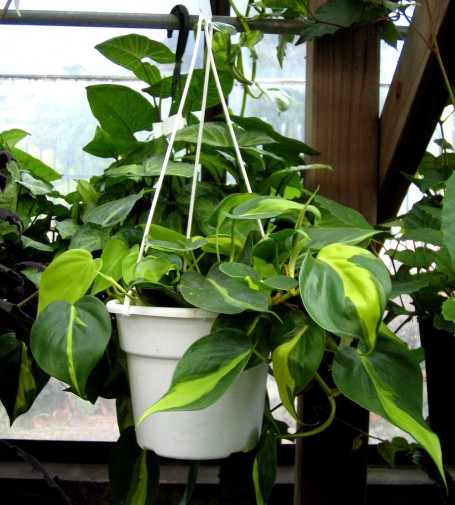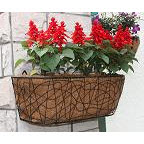
Help Clean Your Inside Air With Air-Scrubbing Houseplants
Posted by Grange Co-op on 5th Jan 2016

Houseplants are an easy and inexpensive way to beautify any room of your home, give it color and character, and allow you to show off your green thumb. But more importantly to your health – and your family’s health – are plants’ incredible “air scrubbing” ability to help improve the quality of your indoor air.
We spend upwards of 90% of our time inside, whether it’s in our home, office, store, or anywhere else that walls and ceilings hold air in, according to the Environmental Protection Agency. What’s worse is that all of this time we spend inside is spent trapped with everyday pollutants that are two to five times higher than outside. These indoor air pollutants include dust, pollen, animal dander and smoke, as well as more harmful carbon dioxide (CO2) and volatile organic compounds (VOCs), which are gases polluting our indoor air that we breathe. VOCs include benzene, formaldehyde, and trichloroethylene, and come in a variety of products such as newer carpets, furniture, synthetic fibers and plastics, paints and varnishes, paint strippers, cleaning supplies, glues, adhesives, building materials, clothing that’s been dry cleaned, air fresheners, insulation, sealing caulks, and other weatherization products.
When we breathe in these pollutants, we suffer a variety of symptoms such as eye, nose and throat irritation, headaches, nausea and vomiting, dizziness, worsening of asthma symptoms. Long-term effects of VOCs include increased risk of cancer, liver damage, and damage to the kidneys and central nervous system.
Sounds pretty scary, right? Thankfully, air scrubbing plants can come to your rescue. While all plants are good for our air quality, specific air scrubbing plants can help rid the air of pollutants.
- As part of their photosynthetic process they add oxygen to the air and actually “scrub” or filter the air by absorbing chemicals like benzene, formaldehyde and trichloroethylene
- Houseplants convert excess CO2 to Oxygen through photosynthesis
- Houseplants also absorb pollution through stomata, or small leaf pores, and by metabolizing contaminants by the microorganisms living in the potting soil
A thorough study by NASA and the Association of Landscape Contractors of America found that many indoor plants can vastly improve air quality in sealed spaces. Six to twelve plants in a standard size room can give complete 100% oxygen exchange by sucking out the bad stuff and putting in fresh oxygen.
The following list of tropical foliage plants are useful in absorbing CO2, benzene, formaldehyde and other common gases given off by man-made products. Most of the plants on this list are low-light adaptive plants and their leaf composition allows them to photosynthesize efficiently under relatively low light conditions, which in turn allows them to efficiently process gasses in the air. Low light tolerant plants have an efficient metabolism, called evapotranspiration. These plants suck up lots of benzene, formaldehyde, and CO2, plus they’re easier to take care of, requiring less water and light.
LIST OF PROVEN “AIR SCRUBBING” PLANTS FOR INDOOR USE
1.
Heartleaf Philodendron, (Philodendron scandens `oxycardium')
2.
Elephant Ear Philodendron, (Philodendron domesticum)
3. Cornstalk Dracaena, (Dracaena fragrans `Massangeana')
4. Spider Plant, Green, (Chlorophytum comosum)
5. Janet Craig dracaena, (Dracaena deremensis `Janet Craig')
6. Warneck dracaena, (Dracaena deremensis `Warneckii')
7. Ficus or Weeping Fig,(Ficus benjamina)
8. Golden Pothos, (Epipremnum aureum)
9. Spathiphyllum, Peace Lily, (Spathiphyllum `Mauna Loa')
10. Selloum Philodendron, (Philodendron selloum)
11. Chinese Evergreen, (Aglaonema modestum)
12. Bamboo Palm, (Chamaedorea seifritzii)
13. Snake Plant, (Sansevieria trifasciata)
14. Red-edged dracaena,(Dracaena marginata)
15. Chrysanthemum, blooming (Chyrsanthemum indicum)
16. Gerbera or Transvaal Daisy (Gerbera jamesonii)
In an 8-by-10 room, with average ceilings, 8 plants from the list above can produce a complete exchange of oxygen in 24 hours. And, 15 to 18 plants from this list, planted in 6-8” diameter containers, in an average 1800-square-foot home can substantially improve the air quality.
One final tip: It’s important to dust all areas of plant leaves as they give off one-third of oxygen from their upper surfaces, and two-thirds from their lower surfaces. The best way to clean plants is to use a dust cloth followed by gently buffing with an old washcloth.
For more Houseplant information and a list of effective air-scrubbing or filtering plants, drop by one of Grange Co-op’s garden centers. Fresh supplies of Houseplants arrive mid-November and early December.
Information taken from the NASA report Interior Landscape Plants for Indoor Air Pollution Abatement, September 1989, by Dr. B.C. Wolverton, Anne Johnson, and Keith Bounds, National Aeronautics and Space Administration, John C. Stennis Space Center, Stennis Space Center, MS 39529-6000.)

